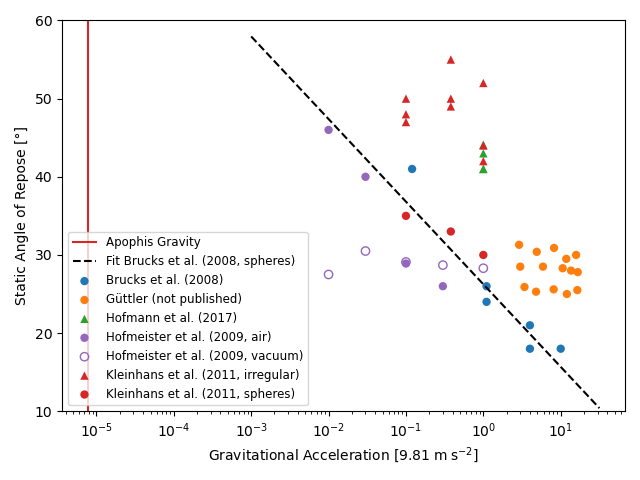Static angle of repose on asteroid (99942) Apophis: development and first tests of a microgravity-vacuum experiment
- Institut für Planetologie, University of Münster, Münster, Germany (lukas.bannemann@uni-muenster.de)
Introduction
Near-Earth asteroid (99942) Apophis will fly by Earth with a distance of approximately 35,000 km on April 13, 2029. Initial predictions gave Apophis an impact possibility of 2.7% (4 on Torino scale) during its 2029 approach but an impact was subsequently ruled out [1]. Nevertheless, Apophis sparked interest of the scientific and planetary defense communities leading to the planning of missions like Satis, RAMSES, and OSIRIS-APEX. The close fly-by of Apophis will lead to interactions of the approximately 370 m large object and the gravitational field of Earth, potentially resulting in regolith avalanches on the asteroid surface (e.g., [2]). Through the aforementioned space missions, it will be possible to observe and analyze regolith avalanches during the Apophis fly-by, providing important insights into properties and behavior of granular materials. One important property of granular materials regarding regolith avalanche formation is the static angle of repose which describes the angle of a slope that has to be exceeded to start an avalanche (e.g., [3]). The static angle of repose of granular materials in microgravity conditions can be experimentally determined on Earth (Fig. 1). These types of experiments, if they come close to the cohesion limit (i.e., small particles and/or small gravity), are sensitive to humidity. Because most microgravity experiments were not performed in vacuum (e.g., [3-6]), microscopic water pockets may have affected the cohesive properties of the granular material and thus the static angle of repose (e.g., [3], [7]). Extrapolation of non-vacuum experiments to Apophis gravity based on a fit from [4] indicates a static angle of repose of about 80°. Furthermore, few results from vacuum experiments [5] show unconclusive results which is why we plan a new set of experiments to study the angle of repose of Apophis’ surface material.

Figure 1: The static angle of repose of several granular materials was determined by experiments [3-6] under varying gravity conditions. Most experiments were performed under atmospheric pressure (filled symbols) and with spherical particles. Only a few in vacuum (open symbols) or with irregular grains (triangles). A fit of experiment results from [4] would predict a static angle of repose for Apophis gravity of about 80°.
Experiment
Our goal is to measure the static angle of repose of different non-cohesive granular materials as well as cohesive granular materials in a tumbler experiment similar to e.g., [3]. The experiment is designed to be performed under Earth gravity in a laboratory environment at the Institut für Planetologie (University of Münster) as well as under microgravity conditions at the ZARM Drop Tower in Bremen. A tumbler of up to 60 mm inner diameter and variable depth is placed inside a stainless-steel vacuum chamber with an inner diameter of 70 mm and will be connected to a Pirani pressure gauge and a ball valve. A glass blanking flange with a diameter of 87 mm will seal the vacuum chamber and the inner experiment volume to fully encompass the granular material in vacuum. The described setup will be slowly rotated along the tumbler axis. We will ensure tumbler rotation rates which will cause the granular material to flow in the discrete avalanching regime [8]. The tumbler system will be placed on a baseplate which can be mounted on a wall for further use in the laboratory or on a centrifuge inside the ZARM drop capsule for experiments in microgravity. The rotation of the centrifuge will simulate artificial gravity during the drop by the acting centrifugal force. Before the start of an experiment, the granular material will be filled to about half of the sample chamber. This is followed by the evacuation of the experimental setup to about 10-2 mbar. The vacuum pump will then be disconnected from the experiment and the chamber shall maintain a pressure better than 1 mbar. Determination of the static angle of repose will be done by analyzing video footage taken by an observation camera. First results of this novel experiment will be presented at the EPSC conference.
Perspective
We aim to run an extensive campaign under Earth gravity (g0) with different shapes and sizes of particles, including sizes that behave cohesive. A reduced parameter set will be studied under reduced gravity, which is expected to be limited to values greater than 10-3 or 10-2 g0. This shall create a sufficient dataset which can be used to extrapolate the static angle of repose of regolith on the surface of Apophis. Combined with computer simulations of the Apophis-Earth interactions, the static angle of repose of Apophis regolith can then be used to determine areas on the surface of Apophis with high probabilities of regolith avalanches and thus areas of interest for imaging. Moreover, comparison of those observations with our experiments shall help to constrain Apophis regolith properties.
References
[1] S.R. Chesley, 2005. Proc. Int. Astron. Union 1. https://doi.org/10.1017/S1743921305006769
[2] G. Noiset et al., 2022. EPSC 2022-1159. https://doi.org/10.5194/epsc2022-1159
[3] M.G. Kleinhans et al., 2011. J. Geophys. Res. 116, E11. https://doi.org/10.1029/2011JE003865
[4] A. Brucks et al., 2008. Earth & Space 2008. https://doi.org/10.1061/40988(323)9
[5] P.G. Hofmeister et al., 2009. AIP Conf. Proc. 1145. https://doi.org/10.1063/1.3180028
[6] M. Hofmann et al., 2017. MNRAS 469. https://doi.org/10.1093/mnras/stx1190
[7] H.M.B. Al-Hashemi and O.S.B. Al-Amoudi, 2018. Powder Technol. 330. https://doi.org/10.1016/j.powtec.2018.02.003
[8] A. Brucks et al., 2007. Phys. Rev. E. 75. https://doi.org/10.1103/PhysRevE.75.032301
How to cite: Bannemann, L., Güttler, C., and Gundlach, B.: Static angle of repose on asteroid (99942) Apophis: development and first tests of a microgravity-vacuum experiment, Europlanet Science Congress 2024, Berlin, Germany, 8–13 Sep 2024, EPSC2024-815, https://doi.org/10.5194/epsc2024-815, 2024.